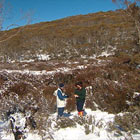During his visit to Kosciuszko National Park, Don met with Glenn Sanecki, a PhD student at the Australian National University. Glenn is studying small animals that stay active throughout winter, particularly those that live under the snow. These ‘winter active’ animals include the Dusky Antechinus, the Common Bush Rat and the Broad-toothed Rat.
Surviving in the snow
Animals living in alpine regions have to contend with long, cold winters, when food is scarce and snow lies permanently on the ground. However, some animal species have developed ways of coping with this harsh environment.
One strategy is to live entirely under the snow during winter. As snow falls and covers the vegetation, particularly in heathland and rocky areas, there is space between the ground and the snow in which small mammals can forage and move. Temperatures remain constant under the snow even though they vary greatly in the open air. The Bush Rat, Broad-toothed Rat and the Dusky Antechinus survive in this way.
However, room to move under the snow is limited, and the winter active species rely on ‘runways’ or corridors to travel around their habitat in search of food. Glenn explained that recent fires have removed a great deal of the ‘shrubby’ understorey, eliminating the support structures that allow the animals to move below the snow.
Winter active
The Dusky Antechinus (Antechinus swainsonii) isa carnivorous marsupial mouse, with sharp teeth and quick reflexes. It lives on a diet of insects, worms, lizards and small spiders, supplemented with vegetable matter.
Because its diet is so varied, the Common Bush Rat (Rattus fuscipes)is able to survive bushfires relatively well. During the fire it shelters in burrows and rock crevices, then emerges to forage for seeds and unburnt plants. In the weeks that follow it live on insects, fungi and new shoots.
The Broad-toothed Rat (Mastacomys fuscus) has dense, fluffy fur to help it keep warm. It is a specialised herbivore, which requires grasses, seeds and shrubs in substantial quantities.
Other alpine species
Glenn spoke about Mountain Galaxia (Galaxias oldius), which are also known as native trout. They are able to survive more extreme cold temperatures than introduced predator species and are thus able to escape by swimming higher. They also throw themselves onto water-soaked rocks in order, it is believed, to warm up in the sunlight.
While the native trout is a great little survivor, the Southern Corroboree Frog (Pseudophryne corroboree) has become extinct in some sites. The recent fires have destroyed a number of sphagnum moss bogs, possibly depleting frog numbers still further.
Dynamics of change
Glenn said that Europeans brought many changes to Australia, and we’re still seeing the dynamics unfold. Don and Glenn agreed that the key to conservation is in fact learning how to manage change for the best outcome, instead of trying to preserve things exactly as they are at any particular time. If we can understand the vectors of change, there’s hope for all of our native plants and animals.
Further information
Glenn Sanecki
Centre for Resource and Environmental Studies
Australian National University
Canberra ACT 0200
Phone: (02) 6125 5013
Mobile: 0412 487 055
Fax: (02) 6125 757
Email: [email protected]



